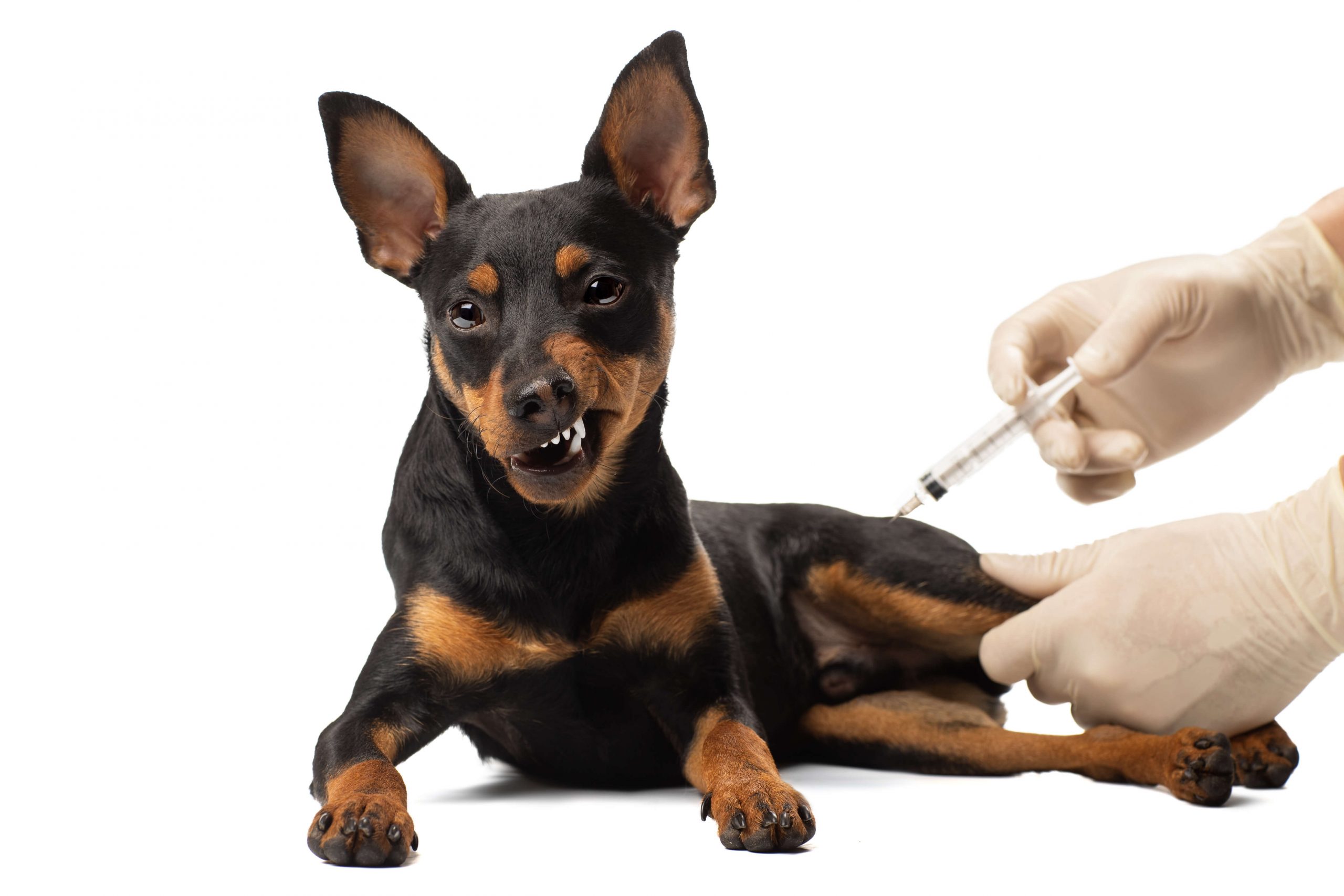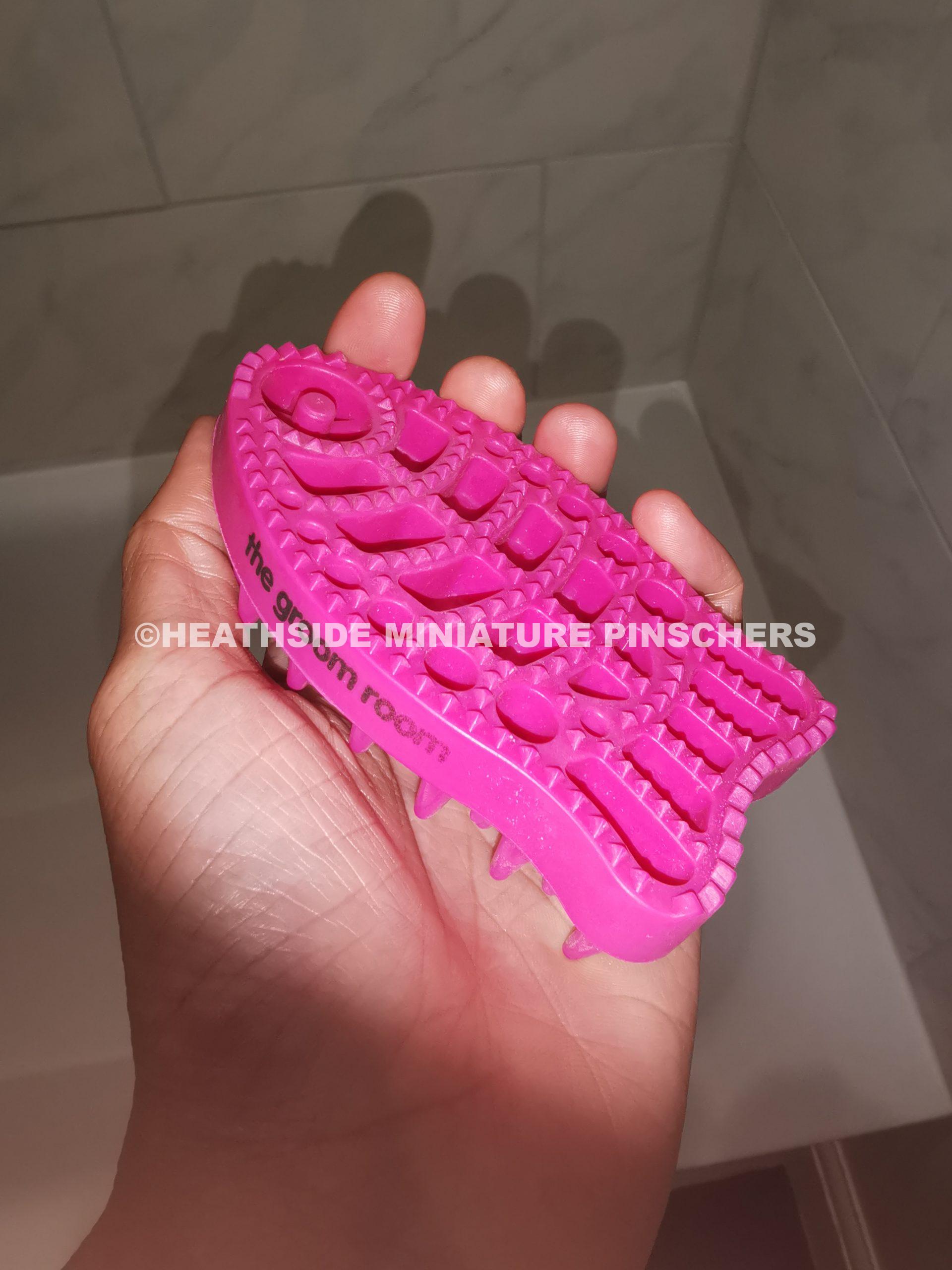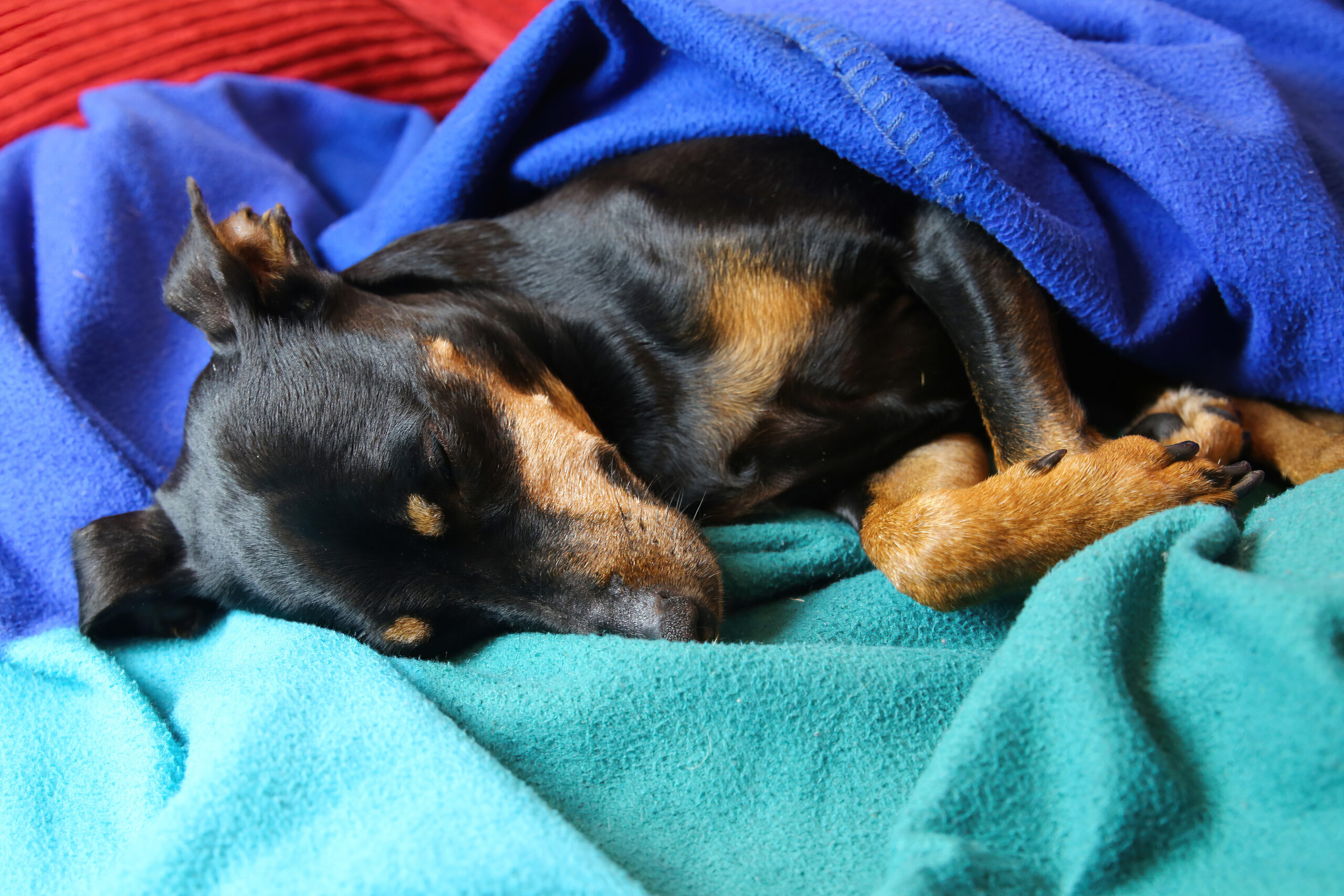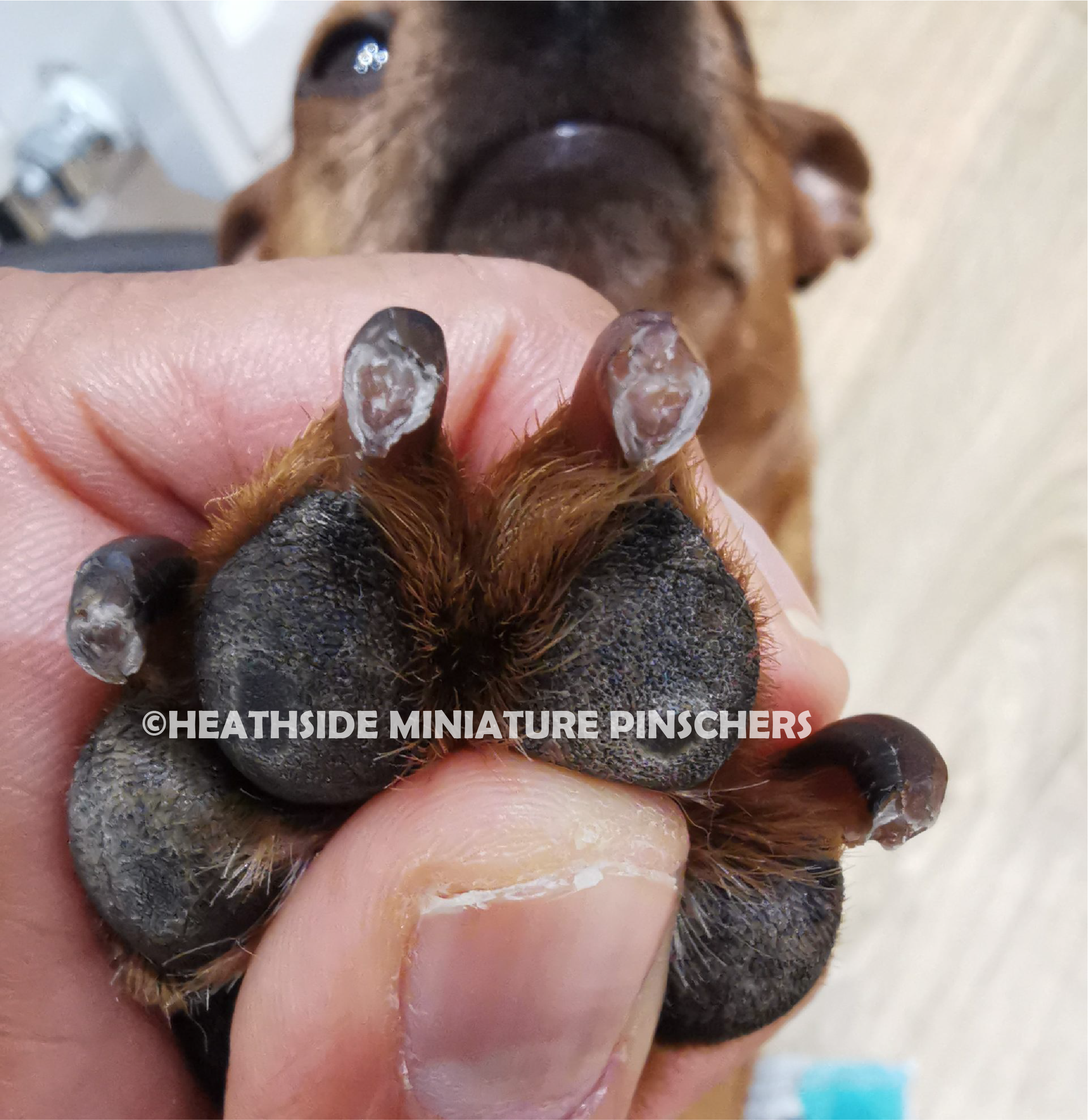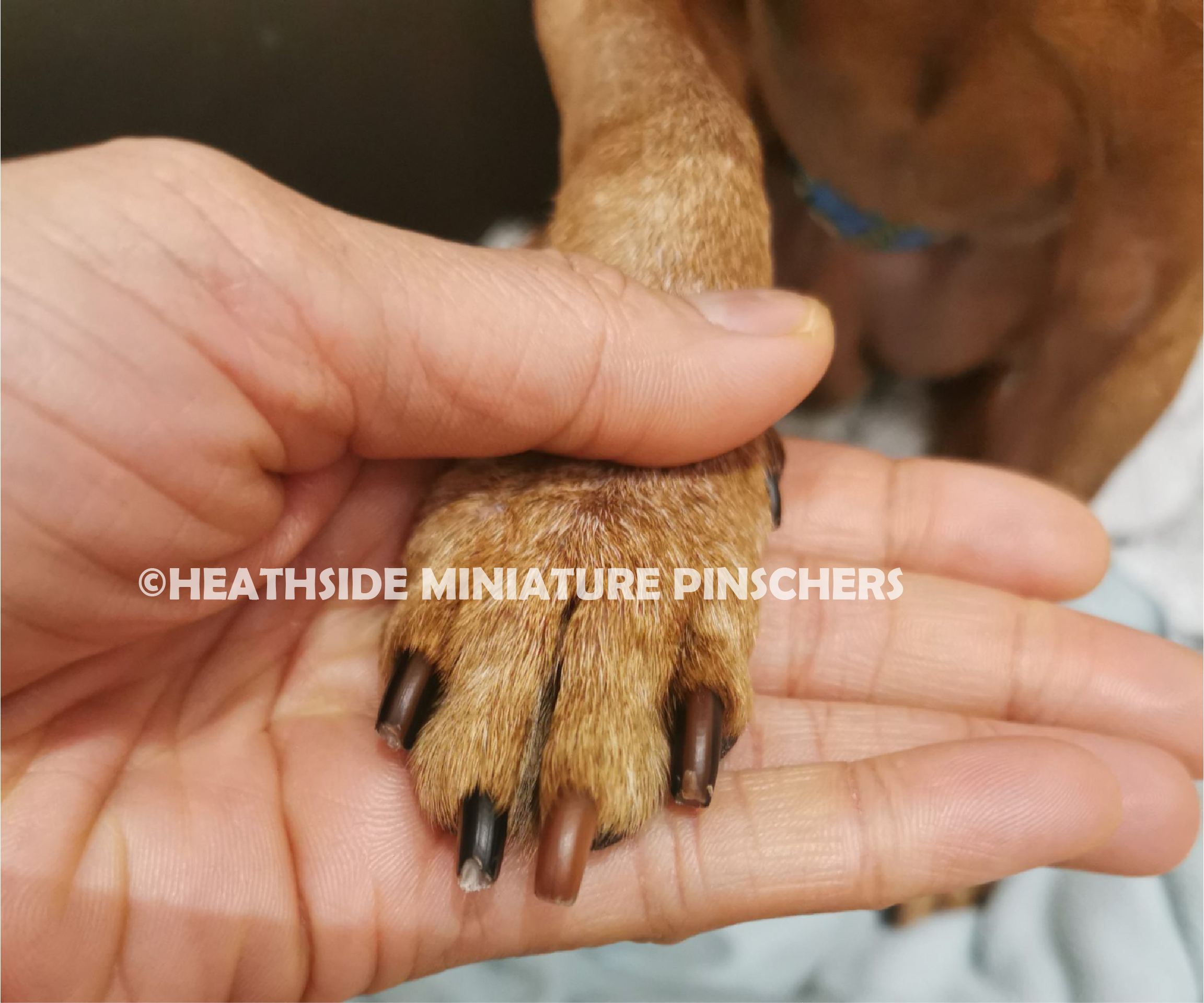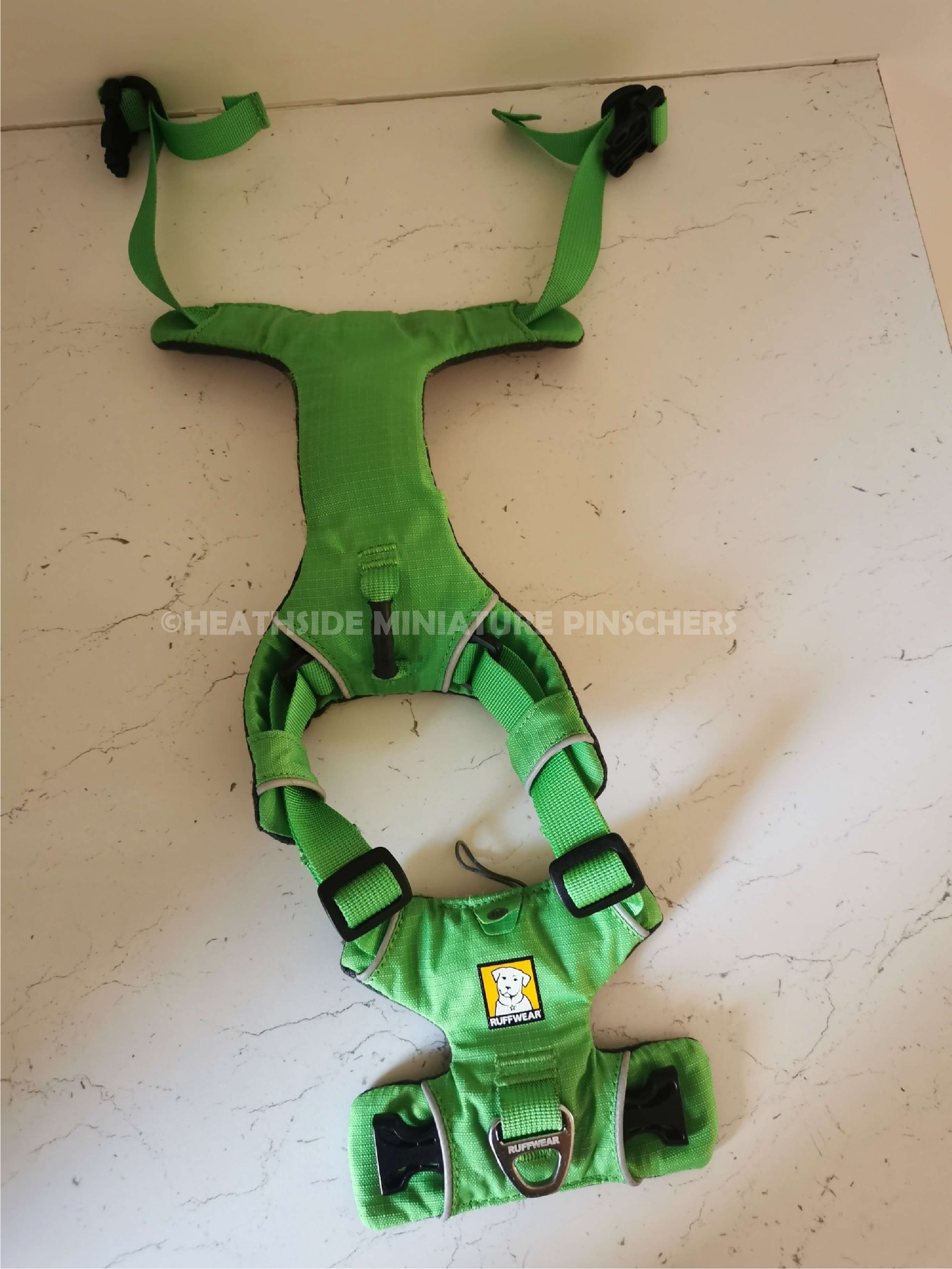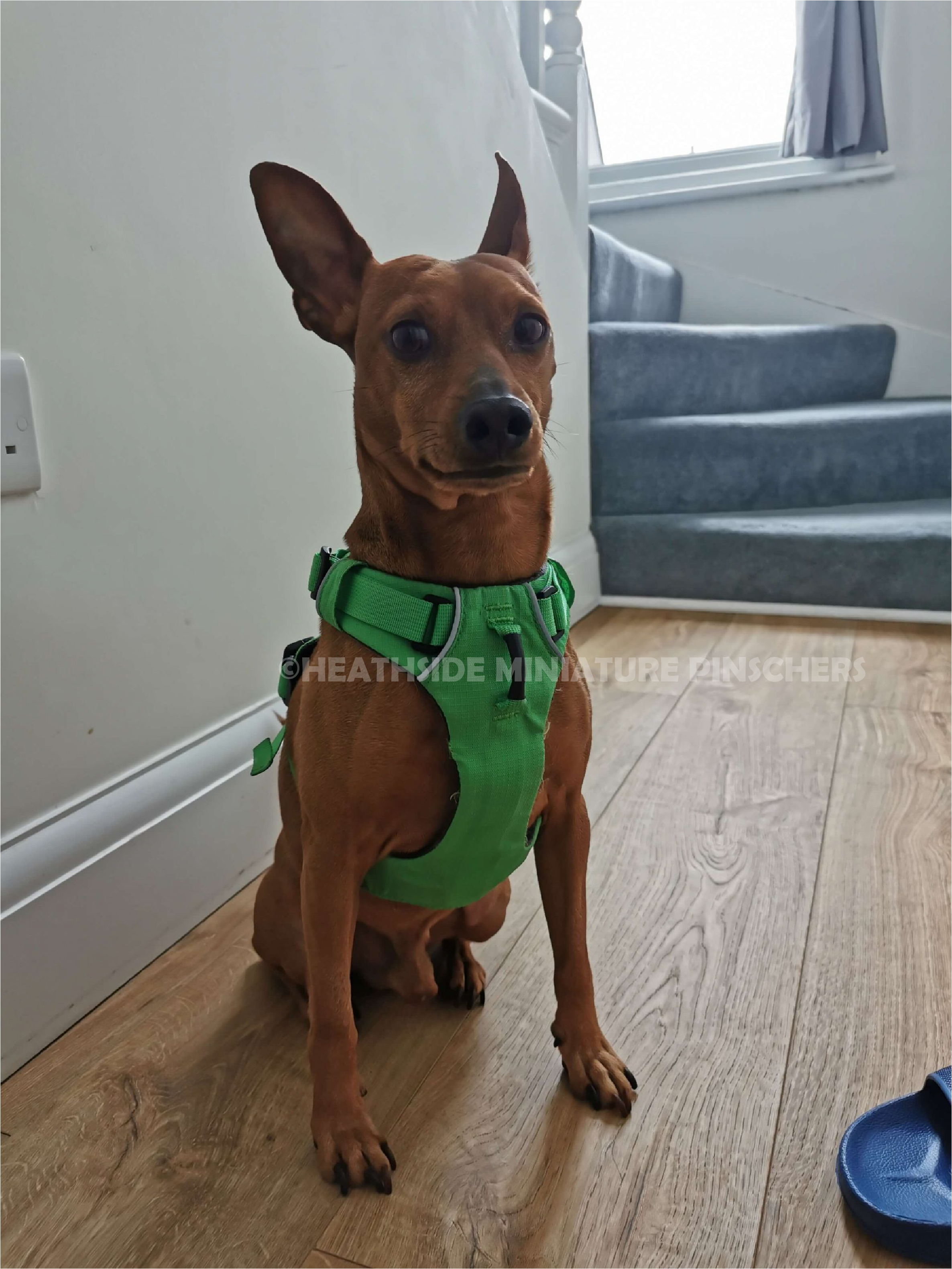Caring For The Miniature Pinscher🐾
Contents
Routine Care🐾
In our experience, minimal routine care is needed for the Min Pin unlike some other similar breeds. For any maintenance regime and it’s associated tools that your Min Pin may be unfamiliar with or have negative experiences with, you should first begin to create and build positive associations. If he isn’t fazed by being handled and groomed, then you don’t have to worry about this. Otherwise, do this exposure training over a period of a week and always once your Min Pin is tired from a day’s play or walks. Ensure he is completely relaxed and ready for napping because it’s in this state that he’s going to be less aroused about anything that’s happening to him. Always use food rewards and praise as you would when teaching basic obedience. Let’s take nail clipping. Begin to handle your Min Pin’s paws and feel his nails, feeding rewards and praising him as you do so then bring out the clippers. Let your Min Pin sniff them and touch them, brushing them against his nails and again, reward and praise. Be very consistent when your doing this and depending on how open your Min Pin is, you may be able to begin grooming routines sooner. If he is particularly nervous and you know he dislikes the bath or nail clippers, then ensure that you don’t expose him for too long at a time. You need to build up his confidence slowly and build up to longer and longer exposure times, until your Min Pin can comfortably be groomed.
Grooming🐾
The Min Pin has a very short, close-lying, smooth hard coat with no undercoat. They do shed twice a year as other short-coated breeds do. This shedding can fluctuate with temperature and general hair loss may be more or less dependent on lighting changes too. The shedding is never too heavy. To keep the coat shiny and avoid any dullness in the colour, however, we recommend can be groomed every other day. This may be contrary to what you may have learned about the frequency with which you should groom short-coated dogs-see here for more. When the seasons change and there is a constant change in temperature, the length of time you will be grooming will be more. We are always very surprised to see just how much loose fur Mikki has and how much comes out when he’s being groomed despite being groomed every other day. To groom him, we use a rubber grooming brush which works wonders for a short coat such as the Min Pin’s as shown below.
We have been through many grooming brushes and we can attest that this product is the best choice! The idea with these grooming brushes is that they double over as a massager for your Min Pin rather than a traditional bristle brush made for short coats because of the thick, wide-set rubber ‘teeth’. Aside from this the loose fur is also very easy to remove as opposed to a bristle brush which is much harder to clean.
Bathing🐾
Next thing is bathing. Although not a necessity but we prefer to bathe Mikki once every few weeks, for cleanliness reasons, which is obviously a personal choice. If he gets dirty when he’s out and about or rolls on the grass, he’ll get a bathing. Frequent bathing along with grooming also keeps the coat looking really bright and shiny-that sheen on the coat is to die for and who doesn’t like a fresh-smelling pooch? However if you intend on bathing your Min Pin often, you must take care in the brand and type of shampoo you choose. Min Pins have sensitive skin which is prone to drying out, getting dandruff and reacting to chemicals easily. Therefore we would advise owners to buy a shampoo specifically formulated for sensitive skin. As well as this, bathing should always be done with a shampoo specifically formulated for a dog’s skin. This means never using human products. A dog’s skin has a very different pH level to ours and human shampoos, conditioners and related products will quickly dry out their skin and cause allergies at worst. We have made mistakes in the past using a human shampoo regularly and this caused Mikki to have skin reactions that lead to all kinds of discomfort. Please avoid this. Buy yourself a dog shampoo. There are some brands available made with a plethora of essential oils which we recommend as they are also more natural and use less harsh chemicals.
This grooming brush has been the best solution for us. See here for more about how to use it to groom your Min Pin properly
Bedding🐾
Min Pins appreciate comfortable bedding probably more than your Labrador does (if you have one!). The reason being is that, providing they are the correct weight, they are lean dogs with a very short coat. Some Min Pins are also naturally small and taken together, their need for comfort is high, as they can likely feel hard flooring and cold drafts very well. Pile up their bed with lots of warm fleece blankets and always make sure they have something soft to sit or lie on. If they are trained to not chew innapropriate items, then a nice soft material bed won’t be unnappreciated!
Nail Clipping/Trimming🐾
Next is nail clipping/trimming. Given their small, narrow paws, a Min Pin’s nails should be trimmed every week. If not, its easy to allow them to grow too long, causing discomfort as they begin to curl over into the paw pad, as we’ve discovered. Just keep an eye on their growth. You have choices regarding maintaining your Min Pin’s nails which are standard scissor clippers, guillotine clippers or dremel. The dremel has it’s advantages over the scissors as you don’t risk so much the common issue of cutting the nerve inside-called a ‘quick’-the nail by accident and therefore we recommend it over the other options. Cutting into the quick will cause bleeding and dogs to never forget the pain, making subsequent nail trimming sessions a nightmare. Dremels which work as an electric file, can be used for those adult dogs who have had bad experiences in the past with clippers to avoid unnecessary stress to them and you. Mikki’s nails were never trimmed in his puppyhood so we’ve had to teach him to accept it in adulthood. There is no hard and fast rule to get your dog to accept nail trimming but it definitely requires a lot of patience. We recommend to begin trimming when your Min Pin puppy or adult is in a relaxed state on his bed. Whether you use a dremel or clippers, using treats can go a long way to getting your Min Pin to cooperate. Give him a small treat every time you finish a paw so he pairs the experience with something positive. Dremels can make a loud sawing-type noise so you may want to get him accustomed to it before you start using it on him. While you’re allowing him to smell it, give him some small treats. When your Min Pin is a puppy, his nail quicks are very small as his nails are small. They grow as the dog matures of course and if your dog’s nails have never been trimmed, the quicks will be very long, almost the length of the nail. This means to get them at a decent length when they are too long, you need to trim the nail every few days just short of the quick and in doing this, the quick will recede naturally and will continue to do so if you trim every few days. When you get to a length you are happy with, just trim less often. Trimming can be easier said than done with a Min Pin’s nails as they are dark or sometimes black meaning you cannot see the quick as easily as you would a lighter nail colour. So the best way to ensure you are not going to cut into the quick, is to carefully eyeball the tip of the nail as you’re cutting as shown in the photo. As you begin cutting, the nail will be white at the tip, so then you keep cutting until you see the quick; if your Min Pin’s nails are dark but not black like Mikki’s, you can see the quick in the centre which is pink (although sometimes it’s a darker colour). If the nails are black, the quick will show up as a dark centre. When you see this it is time to stop trimming until a few days later.
Dogs have an excellent memory for the clamping down sensation of the clippers on their nail. So trimming their nails can be a song and dance with some dogs. This is why we recommend a dremel instead for nervous dogs. For Mikki we still use clippers as we’ve used them for many years so he’s now used to them. Mikki used to scream and become hysterical when it was time for his nail trimming in the past so we started trimming his nails in the bath. The reason being is that he was calm and subdued when he was in the bath which is likely because that’s where he has his baths and as we all know, baths can be scary for dogs! At the moment Mikki is used to having his nails trimmed every other day while we get them down to a length we’re happy with.
Brushing Their Teeth🐾
It is common for dogs in English-speaking countries to suffer with dental problems in later life. It’s reported that 80% of dogs over the age or 2-3 having some kind of dental health issue. This eventually leads to pet dogs needing several of their teeth out by the time they reach their senior years due to gum disease if appropriate action isn’t taken to ensure a healthy mouth. Degeneration of oral health can be slowed or in some cases stopped by every day brushing. We had taken up brushing Mikki’s teeth late (around 4 years old) and it worked wonders for the terrible breath he had. But its important to start this when your Min Pin is a puppy especially if you intend on feeding a diet that is anything but a raw diet. When your Min Pin is on a diet of dry food or canned (wet) food, you’ll see it causes a lot of tarter build-up which contributes to dental problems in the future such as gingivitis and later on periodontal disease, leading to tooth loss. This is because of the high carbohydrate content in the foods. However feeding a fresh diet of meat and healthier, more appropriate carbohydrates or a raw diet, especially from a young age, is the best thing you can do for your Min Pin to have fantastic dental health-see Feeding Your Miniature Pinscher. Otherwise if you don’t currently brush your Min Pin’s teeth it is a good idea to start right away. A hard toothbrush is best or you can use a regular human one. If your Min Pin is new to tooth brushing, see here for more about Mikki’s first time having his teeth brushed. Use a toothpaste specifically made for dogs. Do not use a standard toothpaste made for humans as it contains flouride which is toxic for dogs in large quantities, as well as xylitol, a sweetener usually used in human toothpastes. Ensure you get your Min Pin used to tooth brushing and that it is as much as a positive experience as you can make it. However, there no guarentees that your dog will accept you putting something in his mouth and it will be a matter of trial and error and patience.
Bad Breath
Miniature Pinschers suffer from bad breath. This is because they are one of the breeds which are susceptible to dental issues on top of the damage to dental health that commercial foods such as carb-loaded dry kibble causes. Therefore aside from feeding a healthy diet of either raw or cooked from puppyhood to ensure your Min Pin’s health is in top tip shape, the single best thing you can do is brush his teeth daily. Make sure you buy a good quality toothpaste. If your Min Pin has a lot of tarter build-up from years of dry food, you should see about getting him booked into the vet for a descale, which will remove much of the bacteria in the tarter/plaque, which is responsible for the bad breath. A raw diet will ensure that there isn’t any further tarter build-up. Raw meaty bones can really help keep tarter at bay and aside from keeping your Min Pin’s teeth and gums clean the natural way, raw meaty bones are extremely healthy treats. A raw meaty bone once or twice a week (depending on bone size) is recommended.
Dealing With Parasites: Worming And Flea-ing🐾
Dogs pick up parasites outside. Worming and flea-ing is something that can be a necessity but it also depends on how much time your Min Pin spends outside. Does he go off-lead in nature a lot? Is the area in which he goes for walks in known to have a parasites? It really is lifestyle-dependent. Some owners may find that their dog never has a flea infestation, like us with Mikki. We only treat him when we visibly see fleas either on him or his bedding or in other places around the flat. This is because we believe regular preventative measures are unecessary as we want to avoid exposing him to too many chemicals. The same factors apply to worms as it does to fleas. You can either get wormers and flea treatment from your vet or from a retail or you can use some natural chemical-free alternatives which is what we recommend. For natural remedies to treat worms and how to spot them, see here. For fleas, see here.
Watch out for ticks if you take your Min Pin for exercise in green areas. If you find a tick, they can be removed with tick tweezers which are available to buy in pet shops or online but there’s a method to removing them safely. Green areas especially with long grass can increase the likelihood for all parasites. Check your Min Pin’s fur regularly for fleas and ticks.
Feeding🐾
The same understanding applies to feeding your Min Pin to keep him healthy than it does any other dog breed. That said, there are a few basic things to remember. Toy breeds tend to have faster metabolisms (the smaller the dog the faster the metabolism) and couple that with the fact that the Min Pin is an active breed on the whole compared to other toys, so they tend to burn off calories very quickly. This means you should take care that you are feeding them enough. On the other hand, the Min Pin is one of the breeds that easily gains weight and is prone to obesity. Factors that affect weight in pet dogs are individual stats such as age, ideal weight and everyday activity levels, their diet i.e. what they are fed and how much and, possibly the largest factor, whether or not they are neutered or spayed. Neutered dogs although they do not always eat more cannot regulate their metabolisms properly and so they will be slower, as well as the dog being less active in general. Dogs will be affected in varying degrees. With all things being equal and ensuring that their exercise needs are being met as they should be, they should not be more prone to weight gain than any other breed. Aside from that, correct feeding relies on you first knowing and being honest about your dog’s activity levels and weight and feeding according to those factors. Therefore your dog’s health is in your hands and all within your control. All commercial foods will have feeding guidelines that take the same factors into account (although they are never quite as accurate) and if you are feeding alternatives diets, the same will apply. How many times a day you feed your Min Pin is a personal choice which depends on how often he gets walked (so he can do his business) and for how long but we recommend sticking to a schedule e.g. feed the same time every day. This is because dogs value mealtimes a lot and they are also hardwired to thrive with routines. For us, having a strict feeding schedule helps us know when to expect poops from Mikki so that’s when we take him for a walk. However, if your Min Pin is highly active, you may want to be feeding him more than once a day otherwise he could get very hungry. Other than that we recommend that if your Min Pin is in training for basic obedience or any kind of activity, to ensure he is not fed before any sessions as a hungry dog is far more alert and willing to cooperate when offered food as a positive reinforcer. Visit Feeding Your Miniature Pinscher for more.
Exercise🐾
We’re of the belief that all breeds should have as much exercise as they’re allowed to have because they are dogs and dogs are an active, athletic carnivore. Exercise is the second most important variable after diet for keeping your Min Pin healthy. Experience has shown us just how much energy this little breed has and that as owners we need to provide ways for it to be exhausted. Min Pins should have two good walks or one long walk and, depending on your circumstances and on how active he is indoors, a chance to run around off lead on these walks. We recommend two 30-minute walks or one 1 hour walk a day. This is a general recommendation-some Min Pins will appreciate more time outside. As with all dogs, you should only allow your Min Pin off lead if he has a good grasp on basic recall. Min Pins relish sniffing everything in their environment like crazy (a throwback from their days as small rodent hunters) and would appreciate a chance to do this without being tethered to you. There are many ways that you could help your Min Pin have fun with you and expend his energy-see here for more.
Ear Cleaning🐾
While not a 100% essential part of your Min Pin’s grooming regime, cleaning his ears once a month may be something that you want to consider to stave off the possibility of infections and just to make sure that nothing gets trapped in the canals. As most Min Pins have erect ears whether natural or cropped, the risk of ear infections are low compared to breeds that are born with floppy or low-hanging, droopy ears e.g. a Cocker Spaniel. The lack of air flow and moisture build-up can be a breeding ground for bacteria to grow resulting in infections. Some Min Pins will have ears that never became erect therefore you might be more motivated to have a monthly cleaning regime in place. We recommend a simple cleaning with a cotton swab, a cotton wool ball and an ear cleaning solution;
- Using the diagram as a reference, get a cotton swab and gently bring it into the beginning of the horizontal canal until you get to the end, scrape the swab around a few times, then bring it back out. Then take your cotton wool ball and clean the top part of the ear and the parts that are visible. Do not use the cotton wool to clean inside the ear.
- Take the ear cleaning solution squeeze the liquid into the ear canal as per the instructions on the bottle, then massage the ear at the base to ensure the liquid cleans the ear. Your Min Pin should shake their head to rid their ears of any debris. You can then use a clean cotton wool ball and wipe the visible parts of the ear. If your Min Pin has never had his ears cleaned or has sparse ear cleaning regimes, then you may want to use another swab or two to clean the ears after the cleaning solution.
- As there is controversy around using cotton swabs, you do not have to use them if you are not comfortable with using them and instead, simply use the cleaning solution first as above then a cotton wool ball to clean the visible parts. That said if you do use swabs be very gentle and ensure your Min Pin is relaxed throughout the process.
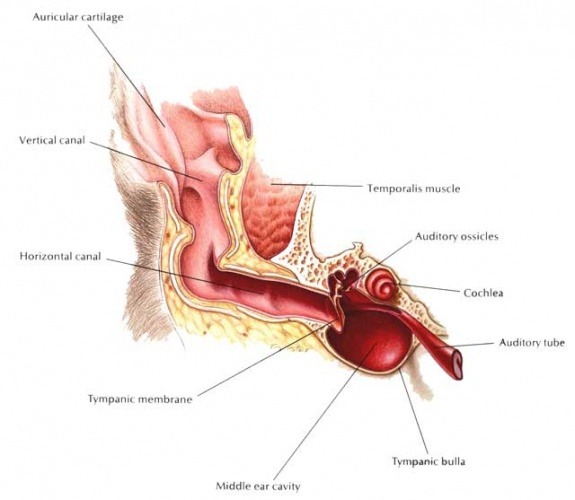
Collar Or Harness?🐾
Anyone who owns a Min Pin knows they love pulling when walking. This can be remedied with training and no product can do the job of proper training but generally, Min Pins are excitable and alert on their walks and won’t always walk steady and calmly. It’s irritating for us at times but its part of a Min Pin’s personality to want to explore everything in their environment, fast. This means as an owner you would do best with using a product that gives you maximum control over your Min Pin while ensuring that he is restrained gently. This is especially important for those dogs that aren’t lead-trained. When a small, slim dog desperately pulls on the lead it can exert a lot of pressure on their throats and windpipes and lead to permanent damage, if they are walked using collars. Some people advise that because of this small breeds should only ever be walked using a harness. Unfortunately, Mikki has some tenderness to that area because of his persistent pulling since puppyhood and every now and then he’ll have a wheezing fit. This was caused by collars we believe and the erroneous thinking that more pressure around his throat would teach him not to pull. This is where harnesses come in. They put no pressure on the dog’s throat as they restrain him around the chest and body. Some harnesses are built for the comfort of the dog more than others. Because of the positioning of the harness straps on a dog, you also have more control over the dog’s body, allowing a more controlled walk for both you and the dog. We own several harnesses for Mikki which have different features and you can see the ones we recommend here. This doesn’t mean your Min Pin cannot ever be walked using a collar. But we suggest is that until he is trained to walk politely on a lead, you should walk him using a harness. It’s vital that you buy the right size harness for your Min Pin as the efficacy of the harness will diminish especially if it is too large. Always ensure that your Min Pin’s collars and harnesses are a comfortable fit and not too tight.
What Kind Of Lead?🐾
We suggest that any kind of lead is suitable. However we 100% stand by our opinion that you should not use an extendable/retractable or Flexi lead until your Min Pin is 100% lead-trained. This means that he is able to walk politely and calmly on a lead at all times without pulling. Basically he should understand lead etiquette. You should ensure he can walk on a lead of different lengths through training. A retractable lead allows freedom at all times and if he is not lead-trained he will be pulling you everywhere. This is because a dog (especially Min Pins who are known pullers) is in a hyper-aroused state outside with all the different and exciting smells, and he will not be able to handle all the freedom an extendable lead can give. First he needs to develop self-control through training. Another thing is that an extendable lead can be a hazard if a dog is not lead-trained for many reasons. Dogs can run into traffic while the lead is extended as well as the lead getting coiled around yours and other people’s legs (causing skin burns from the cord) while they’re greeting other dogs out and about making them a trip hazard.
Play🐾
Min Pins are a highly playful toy breed and you as an owner should understand their need for stimulation. On the whole, they will not enjoy spending their days sitting around like some breeds would but instead will relish you making an effort to engage them in interactive play. You should have plenty of different toys for your Min Pin to stimulate their little brains and to burn some off their energy. Or you can get him involved in some fun doggy games. Mental stimulation is important with this breed particularly if they’re not getting adequate chances to explore their environment on a long walk, then they will need to expend their mental energy indoors. Not being allowed to do this can lead them to become frustrated and possible destructive behaviour. Min Pins have a very strong toy drive and love it when you get involved with their play, which is what we love about them. Interactive toys e.g. tug toys and balls are a winner with Mikki. Something to understand about the Min Pin is that they can be aggressive chewers. Mikki decimated many toys as a puppy but we’ve been lucky as he hasn’t continued to do so over the years. As far as dog toys go the worst offenders are stuffed animals, which are often torn apart fairly quickly with the stuffing inevitably ending up scattered all over the floor. Ensure you clean up all the stuffing fast because they can become a choking hazard and at worst, cause intestinal blockages. This doesn’t mean don’t get them for your Min Pin but ensure you do not to leave him alone with the stuffed toy. Inspect the toy often and if you see that he has chewed a hole, throw it away. Toys that are able to hold treats to keep your Min Pin busy by himself e.g. Kong stuffers, are also excellent as well as treat balls (toys that you can fill with treats). Ensure that with any toys you buy are made for a medium-sized breed to make it less able for him to break off small bits easily and become a choking hazard. An example of this is once Mikki was bought a size XS Kong stuffer made for toy breeds which he chewed so aggressively he broke off a quarter of it and managed to swallow it. Any toy that can fit wholly in their mouth is a no-no. Supervise your Min Pin puppy or dog to see if he is an aggressive chewer. There are many companies producing tougher toys in all shapes and sizes specifically for this issue. Squeaky toys are the most loved (seconded by stuffed toys!) by Min Pins. If you invest in a bunch of thick rubber ones they will be a safe and fun toy to leave your little chewer with.
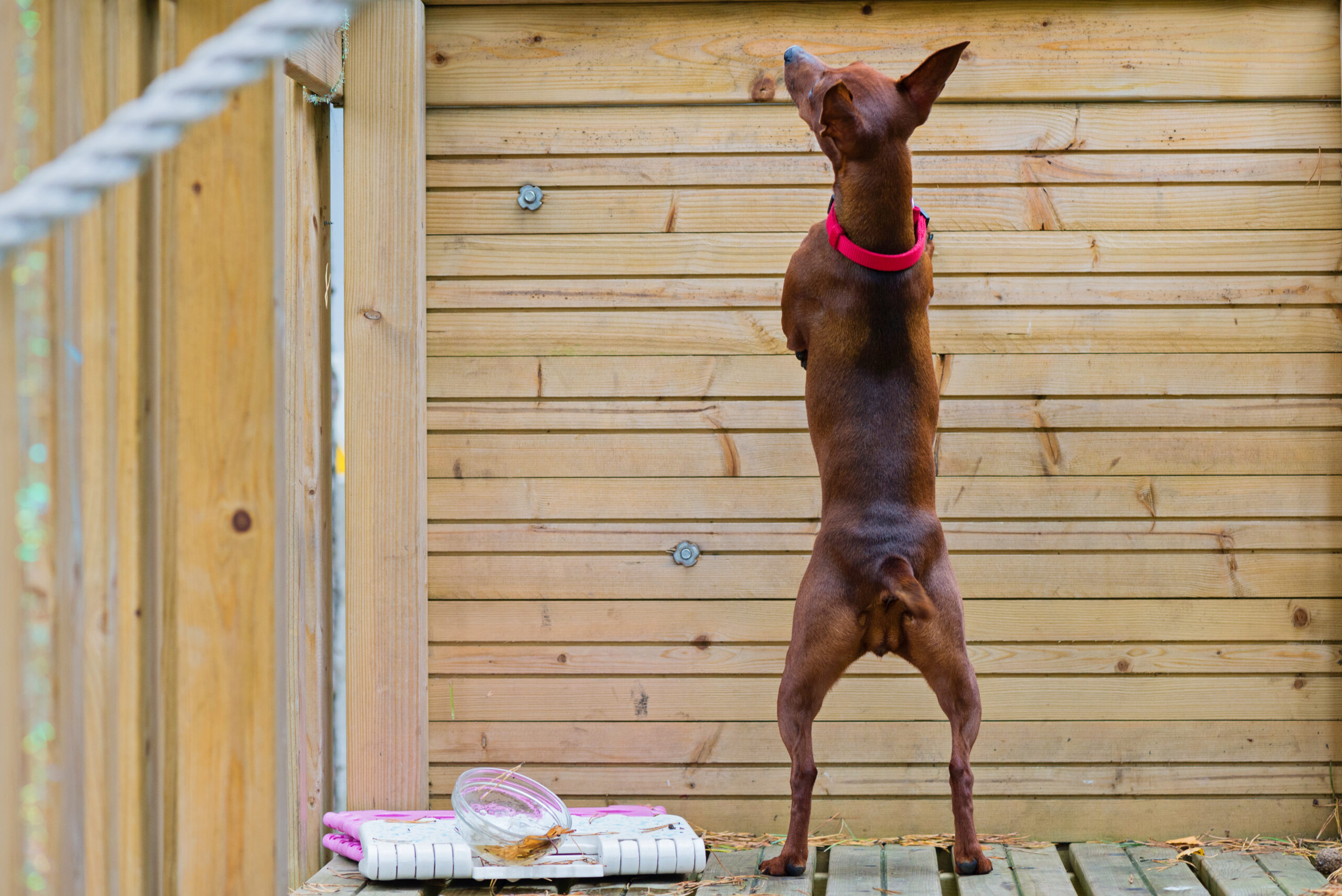
Min Pins are a very curious breed. This means they can escape the confines of your garden if something piques they interest or they catch an interesting scent. Min Pins are known for following their noses! Some are also very agile and can jump fences so it’s important that you take precautions to secure your property
Keeping Your Min Pin Safe And Secure🐾
Fellow Min Pin owners have reported to us the issues they have with their dogs being escape artists. This is because they are highly inquisitive and curious about the world around them especially when they’re outdoors. It’s unusual for them to resist racing around at a zillion mph to explore their surroundings. They may want to check out something that’s grabbed their attention at any cost so couple this with for the most part being a hyperactive breed and you could have a little escape artist on your hands. If you have a garden, care should be taken to ensure it is secured by a fence one that is both high enough so the dog cannot leap up over it and one that cannot be easily compromised by him burying underneath it. The best thing you can do here is to keep your Min Pin under constant watch when it is outdoors and with proper training, you should not have an issue with your little guy going AWOL. Indoors, it may be wise to somewhat Min Pin-proof your home as you would if you had a toddler but in our experience this is only really necessary with puppies. Mikki was very explorative of his home when he was growing up and was always getting into everything he saw, sometimes taking all manner of items and chewing them. You can say this is normal puppy behaviour but it carried on until he was a year old. But as these dogs remain youthful and active throughout their lives it is wise to take precautions. Although it depends on the individual dog, we do not advise allowing Min Pins to be left alone in the garden largely unsupervised, even for a short while unless your garden is secure. With puppies, aside from beginning training as soon as you bring them home, you should keep them on a lead while they explore your garden or you can set up a play pen in to allow them to play while keeping them secure.
Health🐾
A Strong Constitution
Physically, although sometimes fine-boned and dainty-looking with slender legs, the Min Pin is actually a robust, strong and sturdy breed. So contrary to what it’s physical appearance may tell you, it can withstand knocks and falls. The Min Pin is naturally athletic which means they are quite a physically fit dog.
Skin And Coat Health
Min Pins have sensitive skin and at some point in your dog’s life you will encounter dry, flaky (dandruff) and itchy skin and a dull coat to go with it. Dry paw pads can also be an issue. There are topical solutions, supplements and sensitive shampoos to help with dry skin and sore spots-see here for more. However, skin problems can be improved and eliminated with a natural raw diet which we wholly recommend as skin problems are often exacerbated by poor commercial diets such as kibble. Don’t forget to talk to your vet first about any skin problems your Min Pin may have and before you introduce any treatments and to see what they can recommend.
Genetic Predispositions
There are health concerns specifically relating to dogs that have blue coats. Many breeds carry the gene for blue colouring including Min Pins and a condition called dilution alopecia can affect dogs with coats of this colour. Alopecia is a skin condition which can cause thinning fur, fur loss and flaky/itchy/irritated skin. It is an incurable, life-long condition, however, it can be managed pretty easily using the solutions mentioned above. The Min Pin is amongst the healthiest pedigree dogs but as with all breeds they do have their own genetic illnesses and conditions.
- Patellar Luxation is when the kneecap gets knocked out of place and is a genetic fault known to Min Pins but it is easy for breeders to test for. Keeping your Min Pin lean and within normal weight ranges can reduce the severity of this condition- see here for more
- Legg-Calve-Perthes disease causes a reduced blood supply to the head of the rear leg bone, which then begins to shrink-see here for more
- Progressive Retinal Atrophy leads to a very slow but non-reversible degeneration of the eyes and vision, ultimately leading to blindness-see here for more
- Corneal Dystrophy causes the corneas (surface of the eye lens) to become cloudy-see here for more
- Cancers
- Epilepsy
- Thyroid Problems
- Diabetes
- Heart Defects
- Glaucoma
- Cataracts
A breeder who puts good breeding practices first will know their breeding stock and screen for inherited illnesses. Therefore are likely to be more considered in their breeding choices e.g. which dogs to breed together to produce puppies which do not carry genetic defects. Please visit Breeding The Miniature Pinscher for more.
Should I Take Out Pet Insurance?🐾
It’s an important question most dog owners asks themselves especially new dog owners. Is pet insurance worth it for me to take out? Pet insurance is sold based on the risk aversiveness of owners (like any insurance) and if you are one of those people, you probably will be taking out insurance. We asked ourselves this question and we personally were always reticent to take out insurance for Mikki. This is partly because of our experiences with him being that he’s never been ill or shown signs of anything that could progress and partly because we do not want the additional expense. Of course illnesses or conditions can crop up just as accidents can also happen and pet insurance is there to cover the unforeseen. Based on Mikki’s health and the fact he’s a relatively healthy breed, we do not believe taking out insurance is justified, however, we do put money aside for him. Pet insurance is a no-brainer for some small breeds such as the French Bulldog as these dogs, unlike the Min Pin, can be amongst the most unhealthy genetically and tend to fall ill at some point in their lives. However, there are caveats to not taking out insurance for your Min Pin. If you bought your Min Pin from a breeder that hadn’t health screened their dogs or he was a rescue, there is always a risk that he could be carrying a genetic condition known to the breed, in which case you may want to take this into consideration when deciding if you should take out insurance. All that being said, we think that we should consider most as Min Pin owners are the ‘what if’s’, meaning accidents or mishaps. Assuming that your Min Pin is a pet that you don’t take out to work with you or is a working dog (these factors change the type of cover and raise the premiums on insurance) then accidental cover is a great option. This is because it’s cheaper than the type of insurance that covers everything. In our opinion, for this breed, this is the most suitable type of cover particularly if you have an healthy adult, puppy or a younger Min Pin, where illnesses are less likely to be present. Regarding pricing, the premiums for the Min Pin aren’t too high compared to other breeds. A few quotes from the popular insurance companies tends to be around £20 to £30 per month, based on an adult dog with no history of illness. See here for some expert advice about pet insurance. An alternative to insurance is to put money aside regularly or each month for your Min Pin. This is what we do. The obvious advantage is that you avoid the gamble of funnelling money into an insurance policy that you may never need and/or making claims that may not match the value of the premiums you pay. But you need to be disciplined ensuring that you continue to regularly pay into your pet’s fund in case any potential vet’s bills turn out to be on the high side i.e. broken bones can run into the thousands. Another advantage is that instead of paying an insurance premium, you can use that money to budget for treatments that pet insurance doesn’t normally cover, such as dental work and treatments for many other uninsurable conditions.

